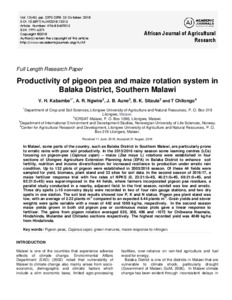Productivity of pigeon pea and maize rotation system in Balaka District, Southern Malawi
Abstract
In Malawi, some parts of the country, such as Balaka District in Southern Malawi, are particularly prone to erratic rains with poor soil productivity. In the 2015/2016 rainy season some learning centres (LCs) focusing on pigeon-pea (Cajanus cajan) – maize (Zea mays L) rotations were established in four sections of Ulongwe Agriculture Extension Planning Area (EPA) in Balaka District to enhance soil fertility, nutrition and income diversification for increased resilience to production under erratic rain condition. Up to 132 plots of pigeon were established in 2005/2016 season. Of these 44 fields were sampled for yield, biomass, plant stand and 32 sites for soil data. In the second season of 2016/17, a maize fertilizer response trial with five rates of NPKS (0, 23:21:0+4S, 46:21:0+4S, 69:21:0+4S, and 92:21:0+4S) was super-imposed in the 44 fields, where farmers incorporated pigeon pea residues, a parallel study conducted in a nearby, adjacent field. In the first season, rainfall was low and erratic. Three dry spells (>10 non-rainy days) were recorded in two of four rain gauge stations, and two dry spells in one station. The soil test results showed low P, K and N status. Pigeon pea plant stand was low, with an average of 2.22 plants m-2 compared to an expected 4.44 plants m-2. Grain yields and stover weights were quite variable with a mean of 442 and 1698 kg/ha, respectively. In the second season maize yields grown in both old pigeon pea or continuous maize plots gave a linear response to fertilizer. The gains from pigeon rotation averaged 620, 308, 496 and -1072 for Chibwana Nsamala, Hindahinda, Mulambe and Chitseko sections respectively. The highest recorded yield was 4049 kg/ha from Hindahinda

